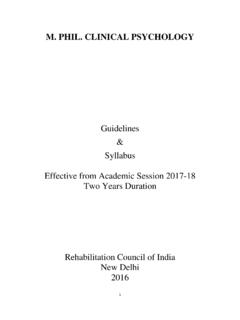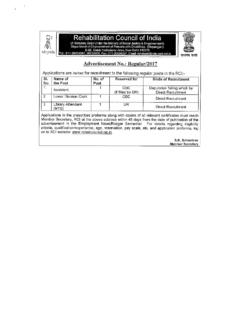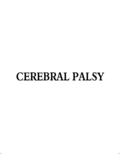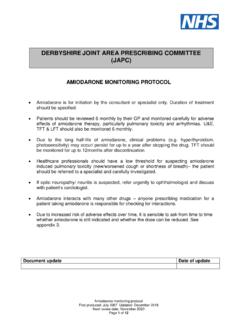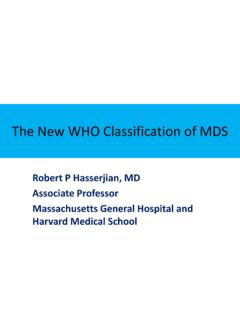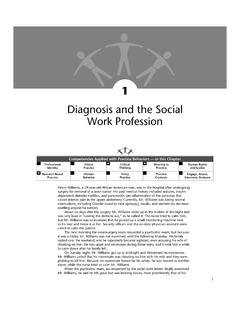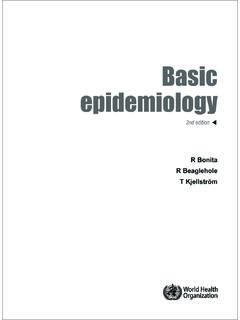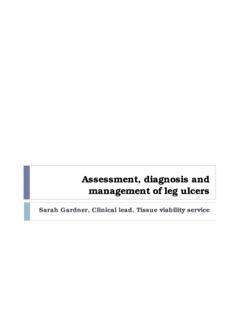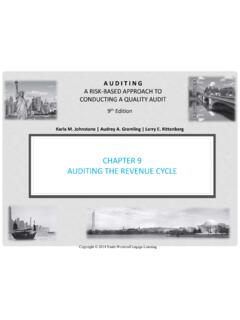Transcription of HEARING IMPAIRMENT
1 HEARINGIMPAIRMENT99 The Ear and Its WorkThe sense of HEARING provides a background,which gives a feeling of security andparticipation in life. It plays a critical role in thedevelopment of speech and language and inmonitoring one s ear is a complex, but delicate structuredesigned to perform a variety of functions: to ableto hear very soft sounds over a wide frequencyrange as well as withstand the very loud sounds, todiscriminate between sounds that vary in pitch andloudness; to be able to locate the direction of arrivalof a sound and in the presence of noise, to be ableto switch on and off a sound of human ear perceives simple tones in therange of 20 to 20,000 Hz and also complex signalssuch as speech and music. Both types of signalsare used in the assessment of HEARING of HEARING ImpairmentConsequences of HEARING IMPAIRMENT willdepend on the ear/s involved, the degree and thetype of HEARING loss and the age of IMPAIRMENT leads to loss of normalverbal communication.
2 Due to distortion ofsounds, differentiation of environmental sounds,including speech, is difficult; making soundslouder does not improve the clarity or quality ofsound. Similarly, recruitment, which is anabnormal growth in loudness, a characteristic ofChapter 1 Introductiondamage to the inner ear, makes it difficult to tolerateloud children with HEARING IMPAIRMENT ,congenital or acquired before development ofspeech and language, normal speech developmentis interfered unilateral HEARING IMPAIRMENT also,there is difficulty in localizing sound, reducedspeech discrimination. Lower speech and languagedevelopment in children has significant effect ontheir educational, linguistic and auditory HEARING -impaired persons have incommon, their difficulty in HEARING spoken andother sounds.
3 They also depend on what they seewhich they supplement to what they sensitivity of each ear ismeasured separately and the severity/degree ofhearing IMPAIRMENT / HEARING loss is generallyclassified in seven categories as per Goodman s(1965) classification and an additional category- slight HEARING loss is added between thenormal HEARING and mild HEARING lossespecially when assessing the hearingsensitivity of young children. Table 1 showsthe classification of severity of 1: Classification of Severity ofHearing ImpairmentClassificationPTA range indBHLN ormal HEARING -10 to 15 Slight HEARING Loss16 to 25 Mild HEARING Loss26 to 45 Moderate HEARING Loss46 to 55 Moderately-severe HEARING Loss56 to 70 Severe HEARING Loss71 to 90 Profound HEARING Loss91 and moreThe level of normal conversational speechis approximately 65dBSPL.
4 Thus, for a person withhearing IMPAIRMENT of 60dBHL or more, verbalcommunication would be difficult. This level ofhearing IMPAIRMENT has been equated as 40% HEARING IMPAIRMENT as in Persons with Disability(Full Participation, Equal Opportunity andProtection of Rights) Act, 1995. The definition ofhearing disabled as stipulated in the PWD Act, 1995is a person who has a minimum of 60dBHL ofhearing IMPAIRMENT in the better ear in speechconversation of HEARING Disability(Threshold + Speech DiscriminationScore Based)The Ministry of Social Justice andEmpowerment, Government of India notifiedguidelines for evaluation of various disabilities andprocedure for certification vide Notification dated 1st June 2001. Procedure forcalculating HEARING disability is based on pure tonethresholds as well as speech discrimination scorein order to arrive at the percentage of the minimum degree of disability should be 40%in order to be eligible for any concessions/ of Disability CertificateThe certificate of disability is to be issued bya medical board consisting of at least threemembers, of which one shall be anotolaryngologist.
5 Percentage of disability can bedetermined considering Pure Tone Average andSpeech Discrimination Score as shown in Table 2: Percentage of DisabilityCategoryType ofPTA of BetterSpeech DiscriminationPercentageImpairmentEar in dBHL Score of Better Earof DisabilityIMild26-4080-100%< 40%II(a)Moderate41-6050-80%40-50%II(b)Severe61-7040-50%51-70%III(a)Profound71-90<40%71-100%III(b)Total>91 Very Poor100%To obtain Speech Discrimination scores,specialized skills, instruments and standardizedtests are required. Neither the range of instrumentsnor standardized tests for speech discrimination invarious languages are presently available in allcenters in the 2 Historical PerspectiveHistorical developments have been dealt withcomprehensively in the Disability StatusReports published by the RCI, in 2001 and then, significant events such as establishmentand support of early identification and earlyintervention centers by the AYJNIHH, Mumbaiand the Disability Helpline initiated during 2004-05 are worthy of of Early InterventionCenters and Training of PersonnelA collaborative project by AYJNIHH,Mumbai and Balavidyalaya, Chennai on EarlyIdentification and Early Intervention towardsInclusive Education of Children with HearingImpairment (0 to 5 years)
6 Was initiated in urgent need was felt to lower the age ofidentification of HEARING IMPAIRMENT andstrengthen intervention service delivery. If a largernumber of children with HEARING impairmentacquire abilities ensuring their success inmainstream education, they pave the way for moreseverely affected children to avail the services ofspecial schools. The gains shown by children whohave gone through the process of early interventionin India were convincing enough to start a greaternumber of early intervention programs on a pilotproject basis. However, the diploma and degreecourses in special education do not focus enoughon aspects of habilitation with very young childrenwith the exception of the Diploma in TrainingYoung HEARING Impaired Children which isavailable only in three centers in India.
7 This wouldmean that any effort to initiate early interventionservices should be accompanied by short termtraining programs for qualified programs should be aimed at equippingrehabilitation professionals to handle aspectsespecially pertinent to very young these issues in view, the project wasevolved. The project was conceptualized in twophases:Phase I:Training of manpower to enablethem to handle very II:Running the early the project, it was decided that a one-month orientation program would be given toalready qualified professionals to work withchildren in the age range of 0 to 5 years. Sevencenters were chosen to run the project, namelyAYJNIHH, Mumbai; its four regional centers atSecunderabad, Delhi, Bhubaneshwar and Kolkata;Balavidyalaya, Chennai and NISH, training package with curriculum specified, videofilms and manual was evolved.
8 The uniformity ofexecution across centers was ensured through aprogram for Training of Trainers (TOT). Tworepresentatives from each of the seven centersattended the TOT program. Each center wasdirected to periodically conduct one monthorientation programs with an aim to have at least 5per year with ten trainees per batch. Special schools102already running programs for pre-school childrenand institutions conducting diploma and degreecourses in special education were approached andencouraged to depute professionals/suggestcandidates from among past students of degree anddiploma courses. Interested fresh and orunemployed special educators were also seven centers under the project werealready providing diagnostic and or interventionservices for children in the 0 to 5 year age it was decided that for the second phase, itwould be ideal to run the intervention programsunder close supervision of these centers.
9 Each ofthe centers could appoint a teacher/speech-language pathologist and audiologist who hadundergone the one month orientation program. Ifa center had more than 25 children, two teacherscould be employed. The center could also appointtwo ayahs/helpers. Until now, the focus was on the0 to year age group. This was reflected in theorientation programs as well which focused onlyon this age group. The next stage of orientationprograms to handle the to year age groupwill be launched in the near future. The project isbeing monitored by an advisory group consistingof senior its commencement in the year 2002,nearly 100 rehabilitation professionals have beentrained through orientation programs to equipthem to handle the 0 to year age group. Nearly150 children with HEARING IMPAIRMENT under theage of years have received intervention at theseven centers under the project.
10 AYJNIHH plansto increase the number of intervention centers bytraining more professionals and also by providingtechnical as well as financial assistance to the HelplineFrequently due to lack of awareness amongthe persons with disabilities and the community,the early identification and rehabilitation processesare delayed. Also the benefits of services offeredby Government and Non-Governmentorganizations for the rehabilitation of persons maynot be availed of by the target group on accountof lack of information. The Disability Linelaunched by AYJNIHH, Mumbai in 2005 wasenvisaged to bridge this gap to some extent byenabling the public to have easy access toinformation regarding disabilities, the servicesavailable in their neighborhood as well as theschemes and concessions offered by , the Disability Line providesinformation about: Different types of disabilities.




